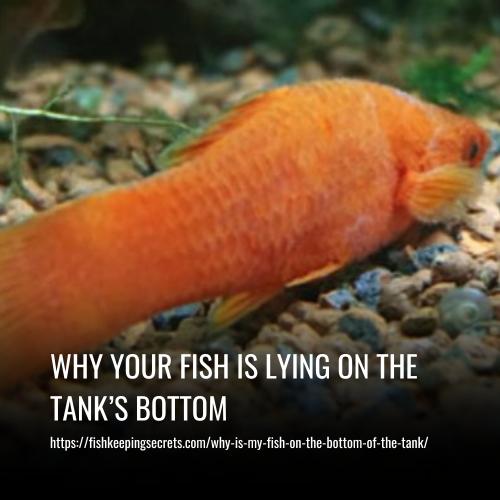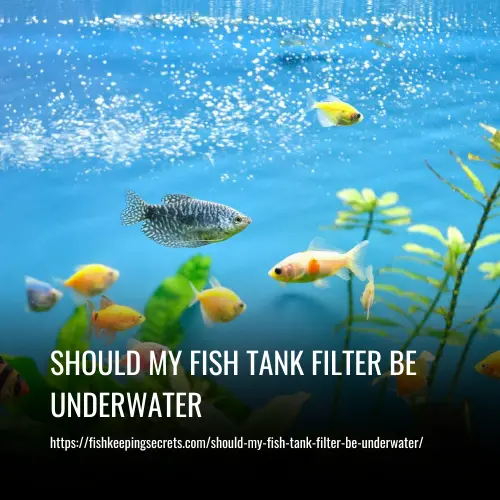Why Your Fish is Lying on the Tank’s Bottom?
This post contains affiliate links. As an Amazon Associate, we earn from qualifying purchases.
Possible seo-friendly answer to “Why is my fish on the bottom of the tank”: your fish may be at the bottom of the tank due to stress, illness, water quality issues, or simply resting or hiding. As a fish owner, you’re probably used to watching your underwater friends swim around and explore their aquarium.
So when you notice one of your fish staying still at the bottom of the tank, it’s natural to wonder why. While sometimes fish may just be taking a break or feeling shy, other times their behavior can indicate a problem.

Causes Of Fish Lying On The Tank’s Bottom
Fish lying on the tank’s bottom is a common behavior that can be a sign of a health problem. As a responsible pet owner, it’s important to monitor their behavior and identify the underlying cause to prevent any further damage.
List And Describe The Different Causes Behind This Behavior
Fish lying on the bottom of the tank can indicate several reasons, such as poor water quality, disease, and stress. Here are the key points:
- Poor water quality: Fish are sensitive to changes in water quality. A lack of oxygen, high levels of ammonia, nitrate, and nitrite, or low ph can stress the fish and cause them to stay at the bottom.
- Disease: Some fish diseases can cause lethargy and loss of balance, leading to them resting at the bottom.
- Stress: Aggressive tank mates, overcrowding, or sudden changes in the aquarium’s environment can cause stress, leading to the fish lying at the bottom.
Types Of Fish That Are More Susceptible To This Behavior And Their Natural Habitats
Some species of fish are more prone to lying at the bottom of the tank than others because of their natural habitats. Here are the key points:
- Bottom dwellers: Species such as catfish and loaches are naturally adapted to living at the bottom of the tank. They are more relaxed and prefer to spend most of their time resting.
- Small-bodied fish: Smaller fish like bettas and tetras are prey to larger fish, and they can hide at the bottom of the tank to avoid predators.
- Shy fish: Some species like guppies and angelfish can get stressed quickly by sudden changes in their environment or other aggressive fish in the tank.
Possible Human Errors That Can Lead To This Behavior
Fish lying at the bottom of the tank can also be attributed to the pet owner’s mistakes. Here are the key points:
- Overfeeding: Excess food left in the tank can rot, leading to poor water quality and stress on the fish.
- Inadequate maintenance: Forgetting to clean the tank regularly can cause a buildup of toxins.
- Improper tank setup: Incorrect aquarium size, lack of filtration systems or lighting, or not enough hiding spaces for the fish can cause stress.
Fish lying at the bottom of the tank should never be ignored. Identifying the cause and taking immediate corrective measures can prevent further health problems. Proper care and monitoring of your pet can ensure they lead a long and happy life.
Signs And Symptoms Of Your Fish Lying On The Tank’s Bottom
If you see your fish lying on the bottom of the tank, it’s a sign of distress, illness, or injury. Depending on the cause, it could be a serious issue that needs to be addressed immediately.
Mention Any Physical Symptoms Or Changes In Behavior That May Accompany This Behavior
Here are some of the physical symptoms and changes in behavior that may accompany your fish lying on the tank’s bottom:
- Lack of appetite or refusing to eat
- Breathing heavily or rapid gill movement
- Clamped fins or tail
- Pale or discolored body
- Loss of balance or floating sideways
- Lethargy or lack of movement
Remember that these symptoms could indicate a range of issues, from water quality problems to bacterial infections. So, it’s essential to investigate the issue further to prevent any harm to your fish.
Use Images Or Diagrams To Help Illustrate The Point
To help illustrate the point better, here’s a diagram that shows some of the factors that could cause your fish to lie on the bottom of the tank:
Solutions To Help Your Fish
If you notice your fish lying at the bottom of the tank, rest assured that it’s not necessarily a death sentence. There could be several reasons for this behavior, and several simple solutions to help them get back to their lively selves.
Here are some useful tips and methods to alleviate the symptoms of fish lying on the bottom, such as improving water quality:
- Conduct regular water changes to keep the water clean and clear of any buildup of waste products that can cause ammonia and nitrite levels to increase.
- Monitor the temperature and ph levels frequently and make the necessary adjustments.
- Check equipment such as filters, heaters, air pumps, and lighting, making sure that they are functioning correctly.
- Add appropriate plant species or other decorative objects that can provide hiding places and reduce stress.
Advice On How To Prevent This Behavior
Prevention is often better than cure, so it’s crucial to maintain a consistent routine to keep your fish healthy and happy. Proper feeding techniques and tank maintenance are essential to prevent your fish from lying on the bottom of the tank.
Here are some tips to consider:
- Feed your fish the right quantity of food, taking care not to overfeed them. Excessive feeding can cause bloating and digestive issues, leading to lethargic behavior.
- Keep a regular cleaning and maintenance schedule, taking care not to overclean as it can upset the balance in the tank environment.
- Keep an eye on the number of fish and their size, ensuring that there is enough space for them to swim around and play.
What To Do If The Behavior Persists?
Despite taking all preventive measures, if you still notice your fish lying on the bottom of the tank, it’s time to take prompt action. Here are some possible steps to follow:
- Conduct a thorough checkup of the fish, looking for any visible symptoms or signs of illness.
- Move the fish to a quarantine or hospital tank, providing isolation and specialized care if necessary.
- Consult with an expert or your local fish store, seeking advice on any specialized treatment or medication that can help your fish recover.
Fish lying on the bottom of the tank can be a cause of concern for any fish owner. But with prompt attention to the symptoms, regular maintenance, and preventive care, you can help your fish enjoy a long and healthy life in their aquatic home.
Just remember to keep the water clean and stable, feed them the right quantity of food, and seek advice from experts and professionals if necessary.
What To Do In The Worst-Case Scenario
Seeing your fish lying on the bottom of the tank can be extremely concerning, but don’t panic just yet – there are things you can do to help. In this section, we’ll explore the options to take if you suspect your fish may be severely ill or injured.
Explain What To Do If The Fish Is Severely Ill Or Injured
If you suspect your fish is severely ill or injured, there are a few things you can do to help. Here are some steps to follow:
- Quarantine the fish: If you have other fish in the tank, it’s important to prevent the spread of any potential disease. Move the sick fish to a separate container or tank to prevent contamination.
- Check water parameters: Ensure the water temperature, pH, ammonia, and nitrate levels are all within the required levels for the species of fish you have. Making adjustments to the water quality can often help sick fish recover.
- Do not feed the fish: Sick fish will often not have the appetite to eat, and giving them food could cause further complications.
- Observe your fish: Watch carefully for any changes in behavior or physical symptoms. Take note of any unusual markings, sores, or bulges, as this could help identify the cause of the illness or injury.
- Seek veterinary assistance: Certain illnesses or injuries may require professional help beyond traditional aquarium care. It’s best to seek veterinary assistance in these cases.
List And Describe The Different Available Treatment Options, Including Medication And Surgery.
If the illness or injury is severe, your fish may require more than just water quality adjustments to recover. Here are some possible treatment options:
- Medication: Antibiotics or antifungal medication can be effective in curing bacterial or fungal infections. Treatments of medication will differ depending on the specific illness and fish species.
- Surgery: In some rare cases, a fish may require surgery, such as if it has swallowed a foreign object or has a tumor. Depending on the case, surgical procedures may be invasive or non-invasive.
- Salt baths or hydrogen peroxide: These treatments can be used to help cure fish of certain parasitic infections or external bacterial infections. However, these should only be used under the guidance of a professional, as incorrect use can be harmful to fish.
Discuss Euthanasia As A Sad But Sometimes Necessary Option.
Euthanasia is the act of ending the life of an animal humanely to prevent further suffering. Though it’s a difficult decision to make, euthanasia may be necessary in some cases where the fish is unlikely to recover or their quality of life has deteriorated to the point where they are in severe pain and discomfort.
It’s important to note that euthanasia should only be conducted by a professional to ensure that it’s done humanely. There are different methods for euthanasia, including using clove oil or an overdose of an anesthetic agent, which a vet can oversee.
Being aware of various treatment options and how to recognize when euthanasia might be necessary can help you take the best course of action for a sick or injured fish. By following these steps, you can work towards the health and happiness of your fish.
FAQs
It might be due to overfeeding, poor water quality, or sickness.
Look for symptoms such as lethargy, loss of appetite, or abnormal behavior.
Quarantine the fish, identify the sickness, and treat it with medication or a water change.
Clean the tank every one to two weeks, or as needed based on the number of fish and size of the tank.
Most fish prefer a temperature between 72-78°f. Research your specific type of fish for their ideal temperature range.
Yes, it can cause bloating and swim bladder issues leading to the fish floating or sinking to the bottom of the tank.
Conclusion
Fishes on the bottom of the tank could be a sign of a problem with their health or environment. Take the time to observe your fish’s behavior and check the water parameters. Ensure that the water is clean, at the right temperature, and oxygenated.
If you notice any signs of illness, seek professional help from a veterinarian. Remember, prevention is better than cure, and proper care and attention to your fish can prevent such problems. Providing an enriched environment with appropriate hiding spaces, plants, and decor can also help reduce stress in your fish, leading to a healthier life.






